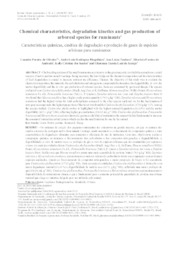Chemical characteristics, degradation kinetics and gas production of arboreal species for ruminants.
Chemical characteristics, degradation kinetics and gas production of arboreal species for ruminants.
Summary: The breeding systems of the small ruminants are extensive in the great majority, in which the animals are created in areas of native pasture named Caatinga, being necessary the knowledge on the chemical composition and its characteristics of feed degradation is crucial to increase nutrient use efficiency. Thereat, the objective of this study was to evaluate the chemical composition, the minerals, the carbohydrates and nitrogenous compounds fractionation, the degradability, in vitro dry matter nd the in vitro gas production of arboreal species, those are consumed by goats and sheeps. The species evaluated were Cnidoscolus phyllacanthus (Muell. Arg.) Pax. et K. Hoffman, Mimosa tenuiflora (Willd.) Poiret, Myracrodruon urundeuva Fr. All., Poincianella bracteosa (Tul.) L. P. Queiroz, Spondias tuberosa Arr. Cam. and Ziziphus joazeiro Mart. It was found that Mimosa tenuiflora has a higher crude protein quantity (174.9 g.kg-1 DM). Spondias tuberosa and Myracrodruon urundeuva had the highest values for total carbohydrates compared to the other species analyzed. As for the fractionation of nitrogenous compounds, the highest proportion of fraction A was found for Cnidoscolus phyllacanthus (375.5 g.kg-1 CP). Among the species studied, Cnidoscolus phyllacanthus is highlighted with the highest ruminal degradation (61.63%) and dry matter digestibility (627.1 g.kg-1 DM), reflecting higher gas production (206.02 mL.g-1 DM). Cnidoscolus phyllacanthus, Poincianella bracteosa and Myracrodruon urundeuva showed a greater availability of nutrients in the rumen which is fundamental to increase the amount of ruminal microbial protein which reaches the small intestine for use by the animal.
Publication year: 2020
Types of publication: Journal article
Unit: Embrapa Semi-arid Region
Observation
Some of Embrapa's publications are published as ePub files. To read them, use or download one of the following free software options to your computer or mobile device. Android: Google Play Books; IOS: iBooks; Windows and Linux: Calibre.
Access other publications
Access the Agricultural Research Database (BDPA) to consult Embrapa's full library collection and records.
Visit Embrapa Bookstore to purchase books and other publications sold by Embrapa.

